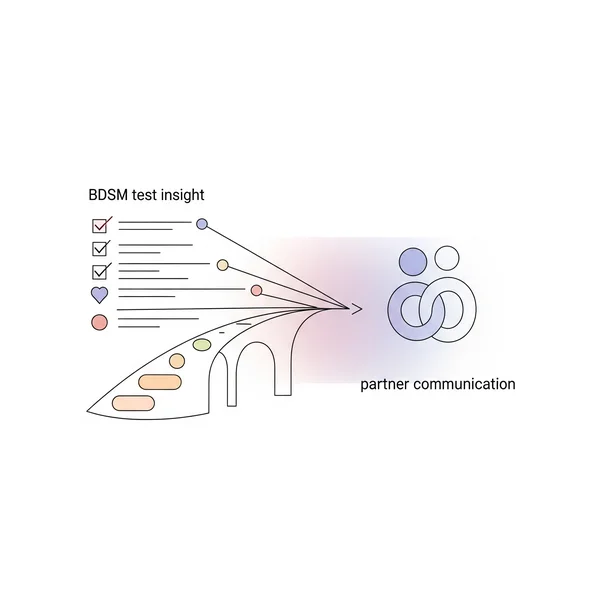BDSM Test Insights: Better Partner Communication
Unlock Better Partner Communication with Your BDSM Test Insights
Effective communication is the lifeblood of any healthy relationship, and this holds especially true when navigating the nuanced and often deeply personal landscape of BDSM. How to talk about BDSM with partner? Many find that while a BDSM test offers profound personal insights, the next crucial step is translating that self-awareness into productive BDSM communication. This article explores how the BDSM test insights you gain from a tool like the one at bdsmtest.online can become a powerful catalyst for fostering better understanding, sharing preferences openly, and ultimately enhancing intimacy and connection in your partner discussion. If you're seeking ways to bridge the gap between self-discovery and shared exploration, discover how your test insights can improve couple communication.
Self-Awareness First: How BDSM Test Results Build a Foundation
Before you can effectively communicate your desires, limits, or role leanings to a partner, you must first have a clear understanding of them yourself. This is where tools like a BDSM test play a pivotal role in building the foundation for successful kink communication.
Understanding Your Own Desires, Limits, and Roles from the BDSM Test Results
A comprehensive BDSM test prompts you to reflect on a wide array of scenarios, preferences, and potential boundaries. The BDSM test results can then crystallize these reflections, offering a more structured view of your potential interests (kinks), your comfort levels with various power dynamics (potential roles like dominant, submissive, or switch), and crucially, your boundaries. This clarity is the essential first step.

Why Clarity in Self-Awareness Precedes Effective Sharing
Attempting to communicate vague or unexamined desires can lead to confusion and misunderstanding. When you achieve greater self-awareness through tools like a BDSM quiz, you are better equipped to articulate your thoughts and feelings with precision. This personal clarity allows you to approach partner discussion with more confidence and coherence, making it easier for your partner to understand and engage meaningfully.
Identifying Key Themes from Your Test for Discussion
Your BDSM test results might reveal recurring themes or particularly strong leanings. Perhaps you consistently show a preference for certain types of power exchange, or a disinterest in specific activities. Identifying these key themes from your BDSM test insights gives you concrete starting points for sharing preferences and initiating a partner discussion, rather than trying to cover everything at once.
Choosing the Right Time and Approach for BDSM Communication
Once you have a better understanding of your own landscape, courtesy of your BDSM test insights, the next challenge is initiating the conversation. The "how" and "when" of BDSM communication are just as important as the "what."
Creating a Safe, Private, and Non-Judgmental Space for Dialogue
Choose a time and place where both you and your partner feel relaxed, safe, and free from interruptions. This should be a dedicated moment for open dialogue, not a conversation squeezed in amidst daily chores or when one person is stressed. A non-judgmental atmosphere, where both individuals feel heard and respected, is paramount for productive couple communication about sexual preferences.

Timing the Conversation: When and How to Approach Your Partner
There's no single "right" time, but generally, avoid bringing up sensitive topics like BDSM preferences when either of you is tired, stressed, or preoccupied. You might say something like, "I've been doing some self-reflection lately, and I'd love to share some thoughts with you when we both have some quiet time. Is there a good time for us to chat this week?" This respectful approach sets a positive tone for the partner discussion.
Setting Intentions for Open and Honest BDSM Communication
Before you begin, it can be helpful for both of you to set an intention for the conversation. This might be simply to understand each other better, to explore curiosities without pressure, or to discuss boundaries for future intimacy. Clearly stating that the goal is open and honest BDSM communication, free from judgment or immediate expectations, can alleviate anxiety.
Sharing Your Preferences: Using Test Insights as a Guide
With a foundation of self-awareness and a safe space established, how do you actually use your BDSM test insights for sharing preferences? This is where the rubber meets the road in kink communication.
How to Talk About Your Kinks and Preferences Highlighted by the Test
Instead of presenting your BDSM test results like a formal report, use them as a springboard for personal sharing. For example, "The test I took brought up [specific kink/interest], and it made me realize I'm curious about that. What are your thoughts or feelings about it?" or "I noticed the test indicated I might enjoy [specific dynamic], which was interesting food for thought for me." Frame it as your personal exploration and discovery, inviting your partner into that journey.

Using Test Insights to Articulate Your Potential Role Leanings
If your BDSM test insights suggest a leaning towards a particular role (e.g., Dominant, submissive, Switch), you can use this to articulate your feelings. "I've been reflecting, and I find myself drawn to the idea of [taking more control/relinquishing control] in certain ways. The test I did seemed to pick up on that. Is that something you've ever thought about?" This approach allows for sharing preferences about roles without making demands.
Discussing Boundaries and Limits Identified Through Self-Reflection
Your BDSM test results can also be invaluable for initiating conversations about boundaries. "One thing that became clear to me through this process is that I'm definitely not comfortable with [specific limit]. That's a firm boundary for me." Clear articulation of limits is a vital component of BDSM communication and sets the stage for safe exploration and deeper intimacy. You might find further guidance by exploring resources on setting BDSM boundaries effectively.
Navigating Partner Discussions: Tips for Empathetic Dialogue
Successful BDSM communication is not a monologue; it's a dialogue built on mutual respect and empathy. As you share your BDSM test insights, be prepared to listen actively and engage empathetically with your partner's responses.
The Importance of Active Listening and Validating Your Partner's Feelings
When your partner shares their thoughts, feelings, or reactions—whether they are curious, hesitant, or even uncomfortable—practice active listening. This means truly hearing what they're saying, acknowledging their perspective ("I understand why you might feel that way"), and validating their emotions, even if they differ from your own. This builds building trust.

Asking Open-Ended Questions to Foster Deeper Partner Discussion
Encourage a deeper partner discussion by asking open-ended questions rather than yes/no questions. For example, instead of "Are you into this?", try "What are your thoughts or curiosities when it comes to exploring different kinds of intimacy?" or "How do you feel about what I've shared?" This invites more elaborate responses and genuine couple communication.
Handling Differences in Preferences with Respect and Understanding
It's entirely possible, even probable, that your sexual preferences or BDSM test insights will differ from your partner's. If this happens, it's crucial to handle these differences with respect and understanding. The goal isn't necessarily to have identical interests, but to understand each other's authentic selves and find ways to navigate those differences with care and potentially explore shared overlaps consensually.
Building an Empathetic Dialogue Around Mutual Exploration
Frame the conversation as a journey of mutual exploration, if both are willing. An empathetic dialogue focuses on understanding each other's desires and limits, and discovering what might be exciting or fulfilling for both of you. Even if you don't share all the same kinks, understanding each other's inner worlds can itself enhance intimacy.
Beyond "Talking": Using Test Insights to Enhance Intimacy
The ultimate aim of better BDSM communication, often sparked by BDSM test insights, is not just to talk, but to connect on a deeper level and potentially enhance your shared intimacy.
How Shared Understanding from Test Discussions Can Deepen Intimacy
When partners feel safe to share their authentic selves, including their kinks, preferences, and boundaries, and feel truly heard and respected, it fosters a profound sense of emotional intimacy. This shared vulnerability and understanding, facilitated by open partner discussion, can be incredibly bonding, regardless of whether or not specific BDSM activities are pursued.

Moving from Conversation to Consensual Exploration (If Mutually Desired)
If, through your couple communication, you discover shared interests and a mutual desire to explore, the understanding gained from your BDSM test insights and subsequent discussions provides a solid foundation for consent-based exploration. You'll have a clearer idea of where to start, what to be mindful of, and how to keep the lines of communication open.
Your Journey Together: Use BDSM Test Insights to Communicate
Your BDSM test can be more than just a personal tool; it can be a catalyst for a richer, more honest, and potentially more exciting relational journey. We encourage you to use the insights gained to foster open and respectful BDSM communication with your partner.
Frequently Asked Questions: BDSM Test Insights & Couple Communication
Navigating these conversations can bring up questions. Here are some common ones:
Should I show my actual BDSM test results to my partner?
How to share BDSM test results? This is entirely up to you and your comfort level, as well as the nature of your relationship. Some find it helpful to discuss general themes or specific points that resonated from their BDSM test insights rather than sharing the raw report. Others might feel comfortable sharing the whole thing. The key is to use it as a tool for sharing preferences, not as a definitive "label" to be imposed.
What if my partner isn't interested in BDSM after our discussion?
What if my partner isn't into BDSM? This is a possible outcome. If your partner expresses disinterest or discomfort, it's crucial to respect their feelings and boundaries. The goal of BDSM communication isn't to convert or pressure, but to understand. Even if you don't share these specific interests, the open dialogue can still strengthen your relationship by fostering honesty and mutual respect for your individual sexual preferences.
How often should we revisit conversations about our preferences and boundaries?
How often to discuss BDSM preferences? There's no set schedule, but it's healthy to revisit conversations about sexual preferences, desires, and boundaries periodically, especially if you are actively exploring. People change, and so can their interests and limits. Ongoing couple communication ensures you both remain on the same page and that consent remains enthusiastic and informed.
Can taking a BDSM test together help our communication?
Yes, for some couples, taking a BDSM test individually and then discussing their respective BDSM test insights together can be a very effective way to facilitate partner discussion. It provides a common framework and can make it easier to broach topics. You can explore the test at bdsmtest.online and decide if this approach suits you.
What if we have very different results on our BDSM tests?
If your BDSM test results are very different, it's an opportunity for deeper BDSM communication and understanding. It doesn't necessarily mean incompatibility. It means you have different landscapes of desire. The focus should be on respecting those differences, finding any potential overlaps for shared enjoyment (if desired), and appreciating each other's honesty in sharing preferences.